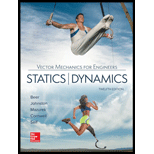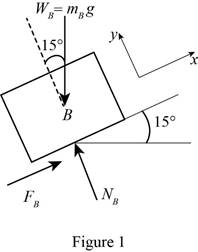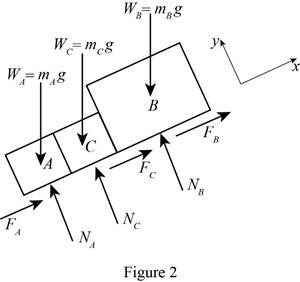
Find whether any of the package moves and the friction force acting on each package.
Answer to Problem 8.14P
The packages A, C, and B will
The friction force in the package C is
The friction force in the package A is
The friction force in the package B is
Therefore,
Explanation of Solution
Given information:
The mass of the package A, B, and C is
The static coefficient of friction between packages A and C and the belt is
The static coefficient of friction between package B and belt is
The kinetic coefficient of friction between packages A and C and belt is
The kinetic coefficient of friction between package B and belt is
Calculation:
Consider the acceleration due to gravity as
Consider Block B:
Show the free body diagram of the block B as in Figure 1.

Resolve the vertical component of forces.
Resolve the horizontal component of forces.
Find the maximum friction force
Substitute 0.10 for
The maximum friction force is less than the friction force.
Therefore, the package C will move.
Consider Block A, B, and C together:
Show the free body diagram of the block A, B, and B as in Figure 2.

The normal force in package A is
The normal force in package C is
The normal force in package B is
The friction force in package A is
The friction force in package C is
The friction force in package B is
Find the total normal force in package A, B, and C as follows;
Find the total friction force in package A, B, and C as follows;
The maximum friction force in package A is
The maximum friction force in package C is
Find the maximum friction force
Substitute 0.10 for
The maximum friction force in package B is
Find the maximum friction force
The maximum friction force is less than the friction force.
Therefore, the packages A, C, and B will
Find the friction force in the package A using the kinetic relation.
Substitute 0.20 for
Find the friction force in the package B using the kinetic relation.
Substitute 0.08 for
Find the friction force in the package C using the kinetic relation.
Substitute 0.20 for
Therefore, the friction force in the package A is
Therefore, the friction force in the package B is
Therefore, the friction force in the package C is
Want to see more full solutions like this?
Chapter 8 Solutions
VECTOR MECHANICS FOR ENGINEERS W/CON >B
- PROBLEM 3.46 The solid cylindrical rod BC of length L = 600 mm is attached to the rigid lever AB of length a = 380 mm and to the support at C. When a 500 N force P is applied at A, design specifications require that the displacement of A not exceed 25 mm when a 500 N force P is applied at A For the material indicated determine the required diameter of the rod. Aluminium: Tall = 65 MPa, G = 27 GPa. Aarrow_forwardFind the equivalent mass of the rocker arm assembly with respect to the x coordinate. k₁ mi m2 k₁arrow_forward2. Figure below shows a U-tube manometer open at both ends and containing a column of liquid mercury of length l and specific weight y. Considering a small displacement x of the manometer meniscus from its equilibrium position (or datum), determine the equivalent spring constant associated with the restoring force. Datum Area, Aarrow_forward
- 1. The consequences of a head-on collision of two automobiles can be studied by considering the impact of the automobile on a barrier, as shown in figure below. Construct a mathematical model (i.e., draw the diagram) by considering the masses of the automobile body, engine, transmission, and suspension and the elasticity of the bumpers, radiator, sheet metal body, driveline, and engine mounts.arrow_forward3.) 15.40 – Collar B moves up at constant velocity vB = 1.5 m/s. Rod AB has length = 1.2 m. The incline is at angle = 25°. Compute an expression for the angular velocity of rod AB, ė and the velocity of end A of the rod (✓✓) as a function of v₂,1,0,0. Then compute numerical answers for ȧ & y_ with 0 = 50°.arrow_forward2.) 15.12 The assembly shown consists of the straight rod ABC which passes through and is welded to the grectangular plate DEFH. The assembly rotates about the axis AC with a constant angular velocity of 9 rad/s. Knowing that the motion when viewed from C is counterclockwise, determine the velocity and acceleration of corner F.arrow_forward
 International Edition---engineering Mechanics: St...Mechanical EngineeringISBN:9781305501607Author:Andrew Pytel And Jaan KiusalaasPublisher:CENGAGE L
International Edition---engineering Mechanics: St...Mechanical EngineeringISBN:9781305501607Author:Andrew Pytel And Jaan KiusalaasPublisher:CENGAGE L
